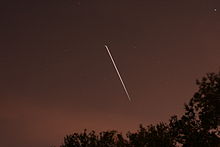
An orbital pass (or simply pass) is the period in which a spacecraft is above the local horizon, and thus available for line-of-sight communication with a given ground station, receiver, or relay satellite, or for visual sighting. The beginning of a pass is termed acquisition of signal (AOS); the end of a pass is termed loss of signal (LOS).[1] The point at which a spacecraft comes closest to a ground observer is the time of closest approach (TCA).[1]
© MMXXIII Rich X Search. We shall prevail. All rights reserved. Rich X Search
